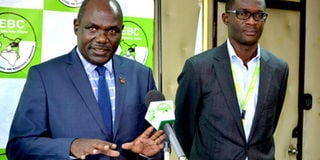Untold sweet-and-sour stories from Kenya’s election drama

Independent Electoral and Boundaries Commission (IEBC) Chairman Wafula Chebukati (left) and CEO Ezra Chiloba at Anniversary Towers, Nairobi, on April 5, 2017. PHOTO | SALATON NJAU | NATION MEDIA GROUP
What you need to know:
This time, supporters of President Uhuru Kenyatta demonstrated to rally behind their man.
The August 8 presidential vote were treated even less seriously than those in the election of the chairman of a village cattle dip.
Chebukati said officers did not bother to even send the results from nearly 600 polling stations, and there were reports of returns being made on supermarket stationery.
On Tuesday, the drama continued from the September 1 unprecedented decision by the Kenyan Supreme Court to annul the August 8 presidential election, and to order a repeat poll within 60 days.
This time, supporters of President Uhuru Kenyatta demonstrated to rally behind their man. And on Wednesday, the Supreme Court justices delivered their full ruling.
This was no ordinary election, and something about it has intrigued me. It’s not being debated much but was starkly highlighted in the recent letter by the Independent Electoral and Boundaries Commission (IEBC) chairman, Wafula Chebukati, to the body’s CEO Ezra Chiloba to explain what went wrong with the election.
It is that the results of the August 8 presidential vote were treated even less seriously than those in the election of the chairman of a village cattle dip.
Chebukati said officers did not bother to even send the results from nearly 600 polling stations, and there were reports of returns being made on supermarket stationery.
POLITICAL CONTEST
In the current political contest, the opposition alleges that these are straight-out signs of electoral fraud. But if they are not?
It’s not easy to find many people in Kenya who are looking at the election tug-of-war with humour and cold dispassion. But I did meet up with one — a dry-eyed realist who helped to unravel some of the mystery.
He has many stories he’s collected about last month’s election.
One that stuck out was about how the presidential ballots were treated in some parts of the country, especially where the communities there did not have a high stake in the presidential contest because they are not caught up in the Western-Rift Valley-Central Kenya triangle’s historical contest for State House.
PRESIDENTIAL BALLOTS
He said that in some of those places people would basically say things like “count the presidential thing very quickly and get it out of the way” so that they would get on to “count the votes in the real election”. By “real election” they meant the race for governor and member of the county assembly.
It all conjured up the possibility of ‘orphaned’ presidential ballots lying neglected in the corner of rooms as everybody gathered around the governor and MCA papers, peering at each closely and haggling over whether they were valid or not.
‘Emotional devolution’
We will need evidence for this but, if the chronicler’s account is true, then it would seem that, in a few places, the problem with the presidential election was that no one would be bothered to count the ballots and transmit the results!
In his view, after the post-election violence of 2008 and the 2010 Constitution that devolved political and several economic powers to the counties, the 2017 General Election saw another round of devolution. There was, in his view, a large “emotional devolution to the counties”.
PETITION
In other words, the attractiveness of the centre in Kenya continues to diminish.
If he is right, then both the Nasa election petition and the defence of the presidency by Uhuru supporters have one thing in common: They are an attempt by what somebody once called the “Nyanza-Kiambu centrists” to reassert the place of the capital Nairobi as the heart of Kenyan politics.
Inevitably, we got to discuss the western Kenya secession petition.
He didn’t think it would succeed — just yet. Its significance, he said, is that it is an attempt at aligning the “emotional devolution” he spoke of, which has been happening in parts of Kenya since Independence, with a territorial map, in this case western Kenya.
And it’s not a new thing. Five years ago, it was witnessed at the Coast in the ill-fated push by the Mombasa Republican Council for a sultanate. It has been reported lately that, in 1998, some politicians in the mountain region spoke of the creation of a “Central Kenya Republic”, to escape from the torment of the Moi years.
One way to put this is to compare it to a very human situation. A young man wants to get married. After some time, he finds the love of his heart and decides she is the one he will marry. Next, he has to propose. And she — and possibly her family — has to say yes. Then the wedding has to happen.
These elections have been a reminder that parts of Kenya have fallen in love with deep devolution/secession. But that is no guarantee that it will end in a wedding.
Mr Onyango-Obbo is publisher of Africa data visualiser Africapedia.com and explainer site Roguechiefs.com. Twitter@cobbo3





